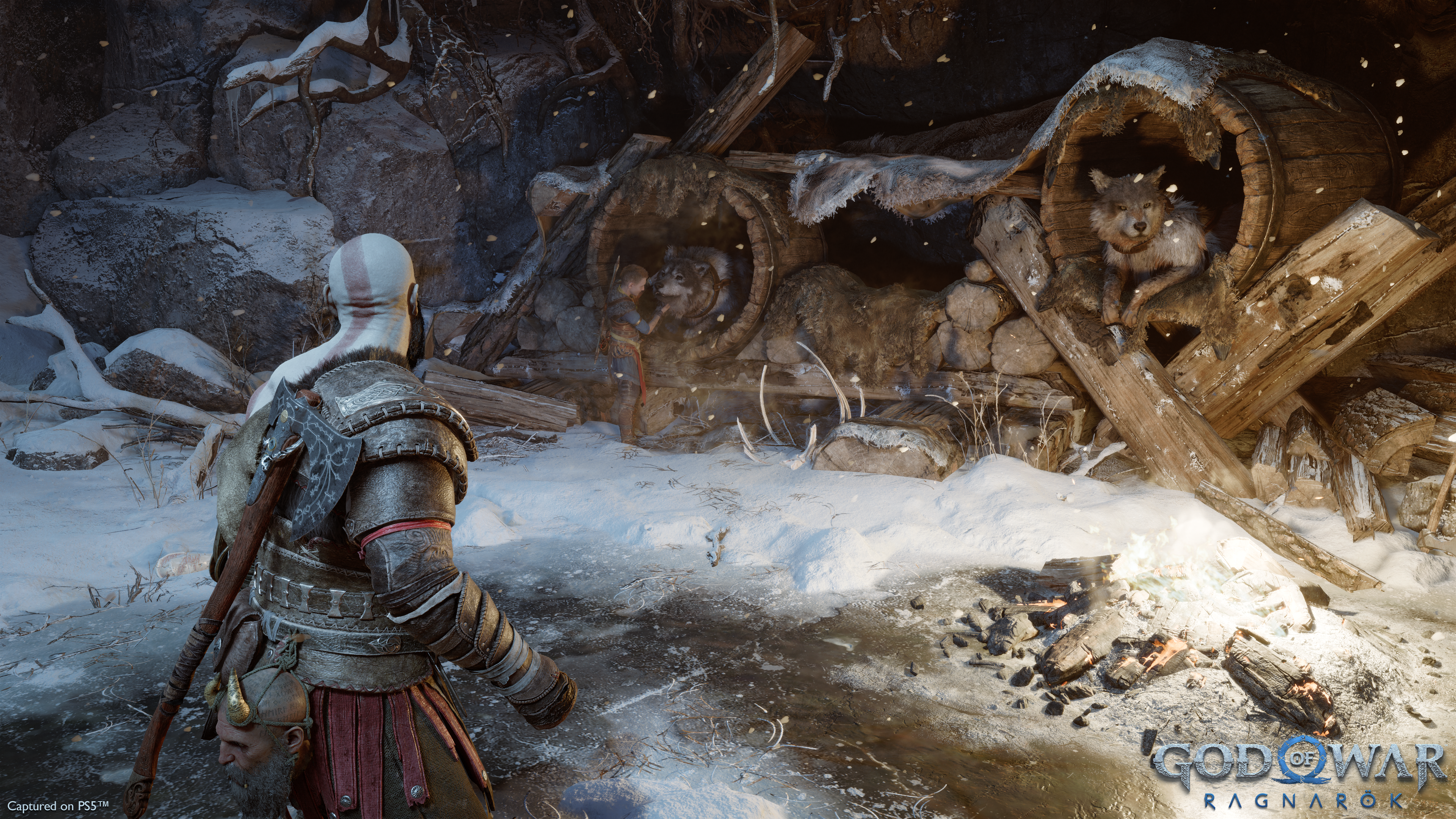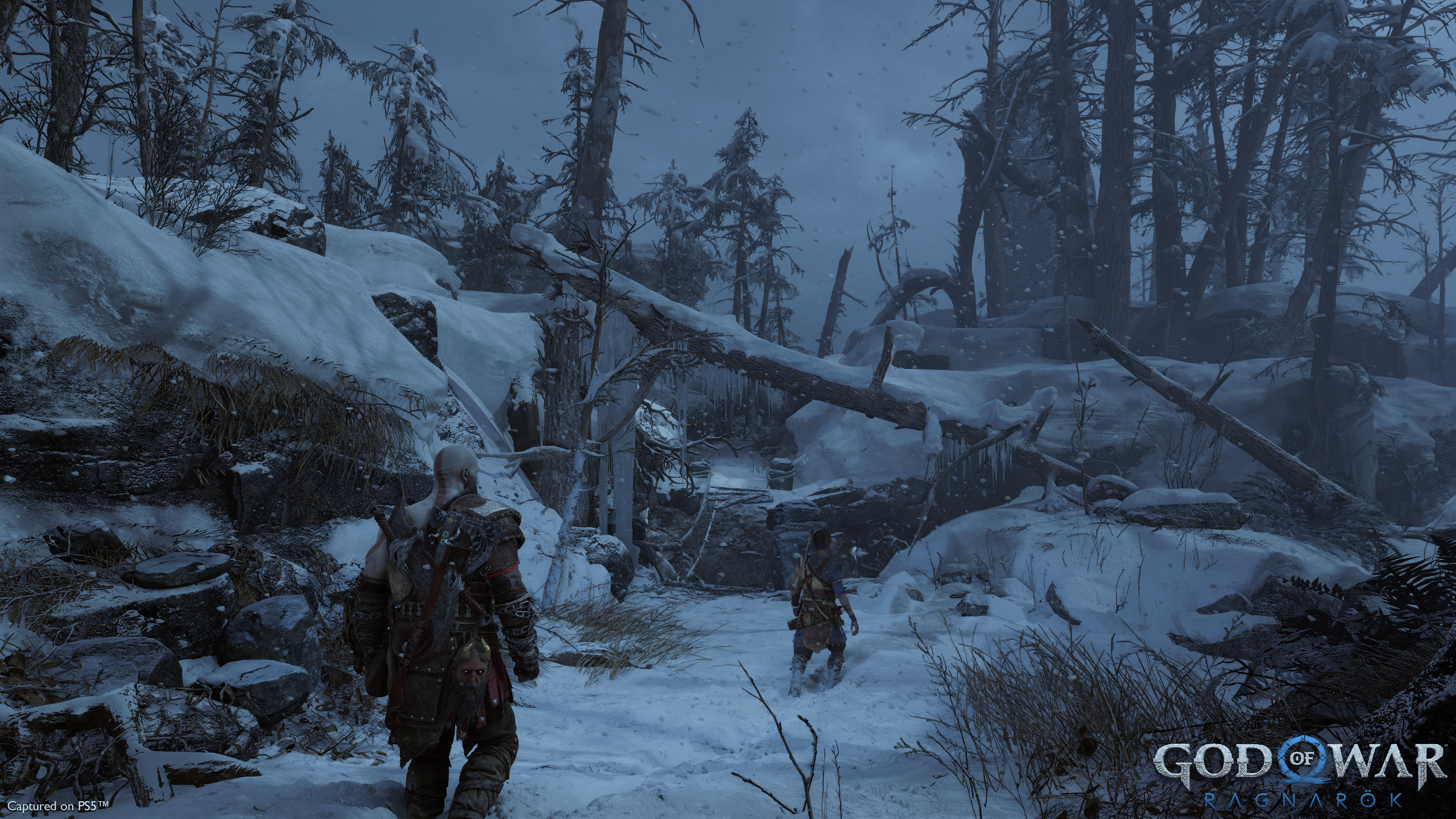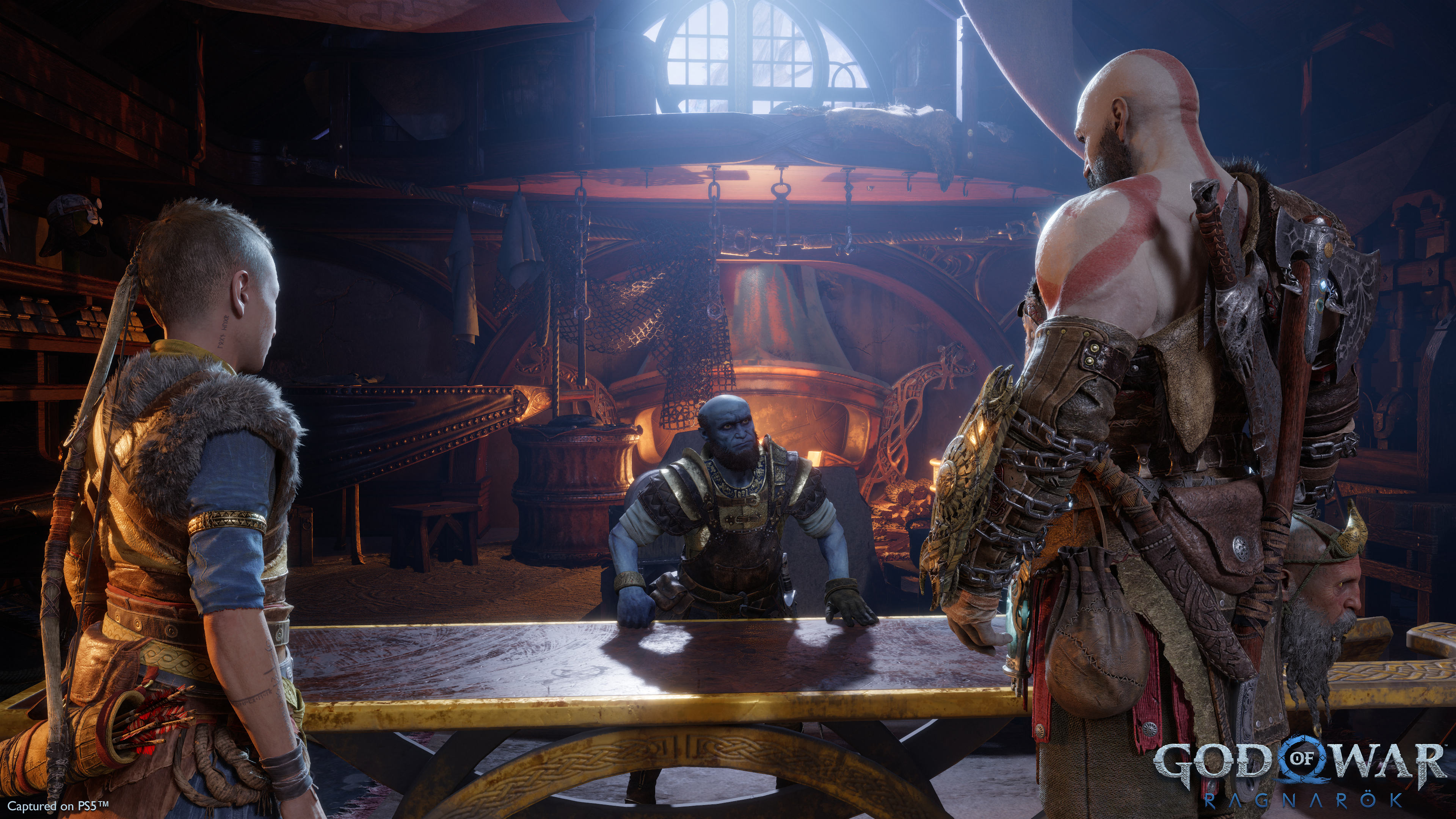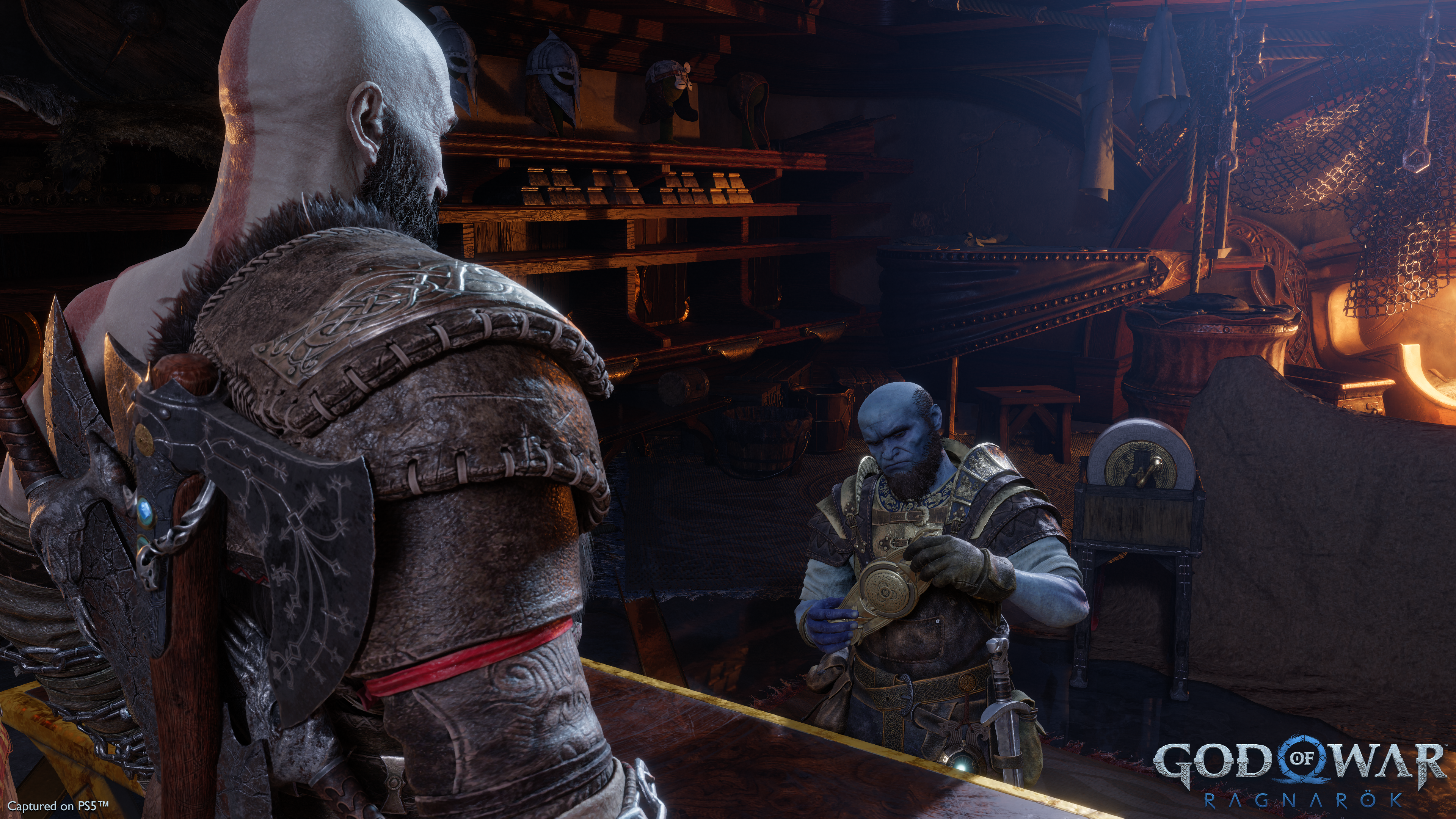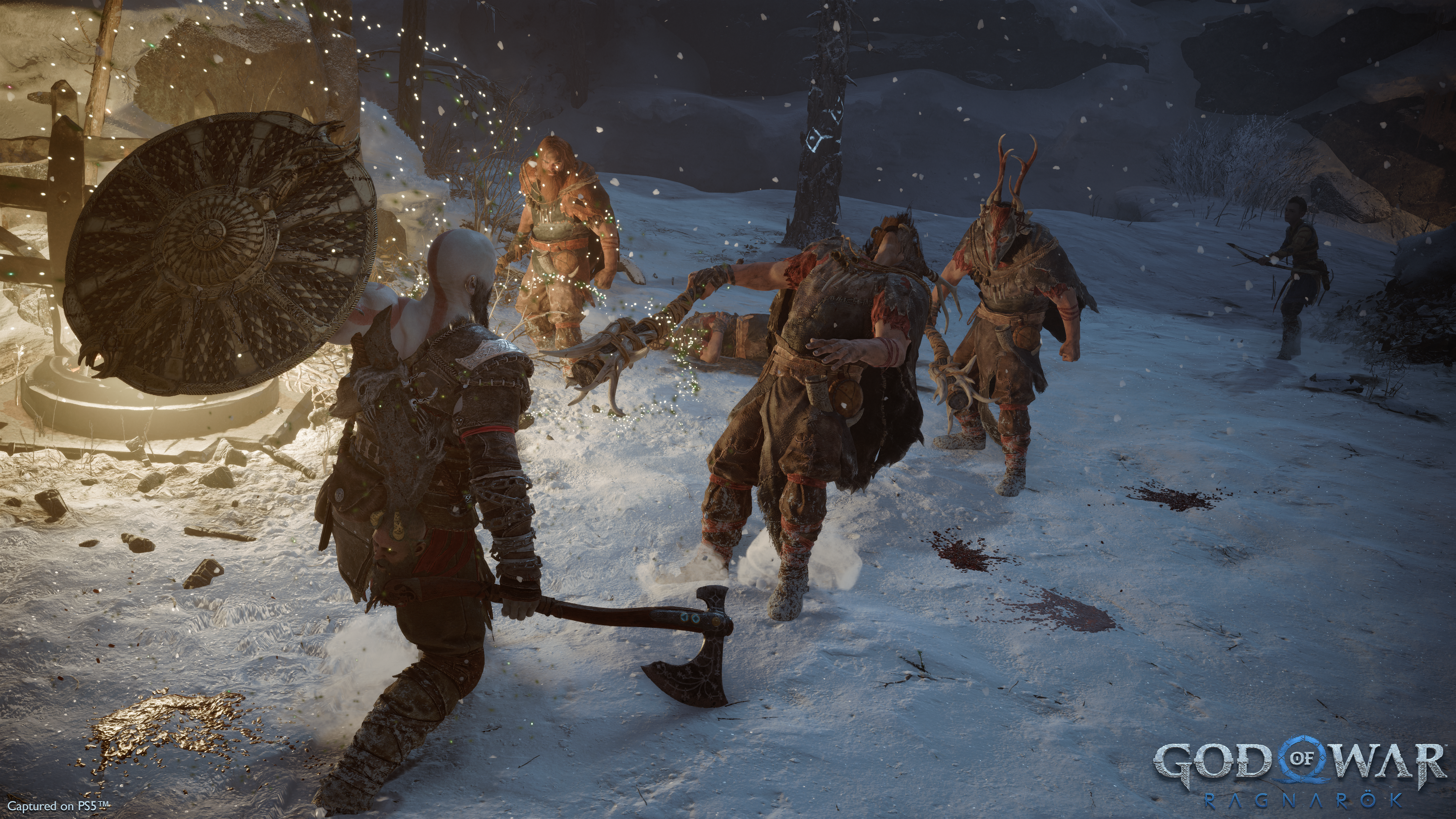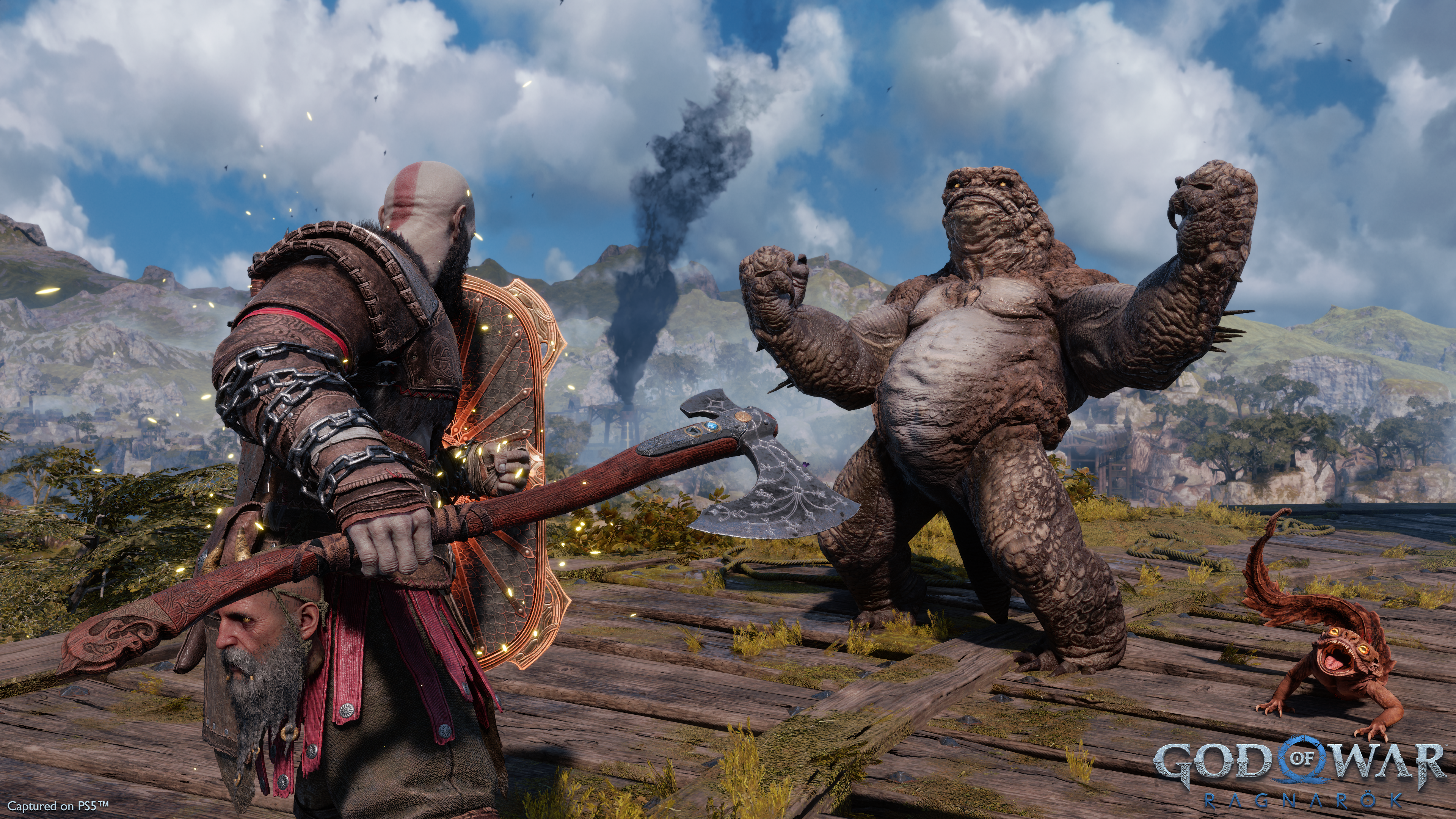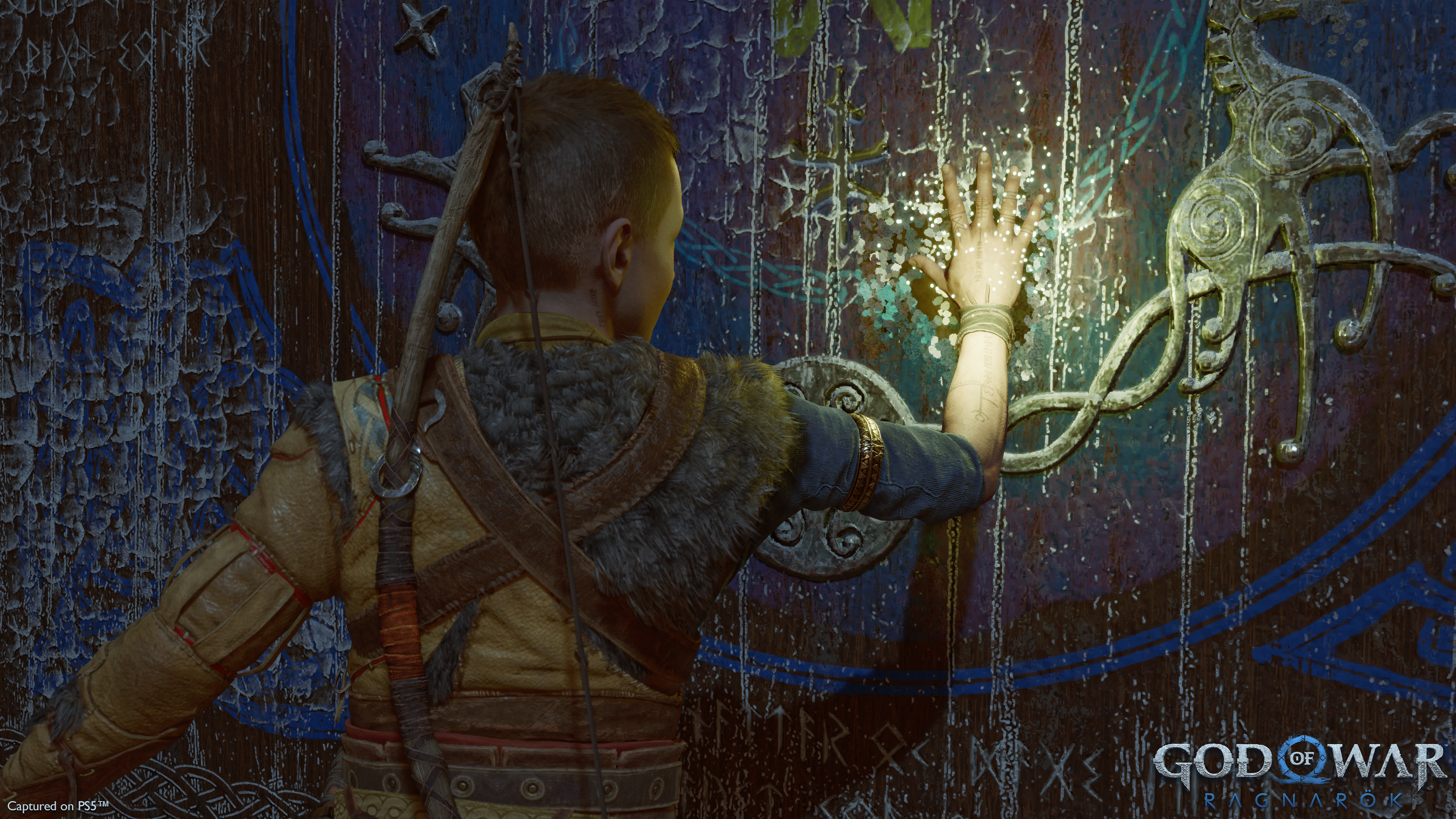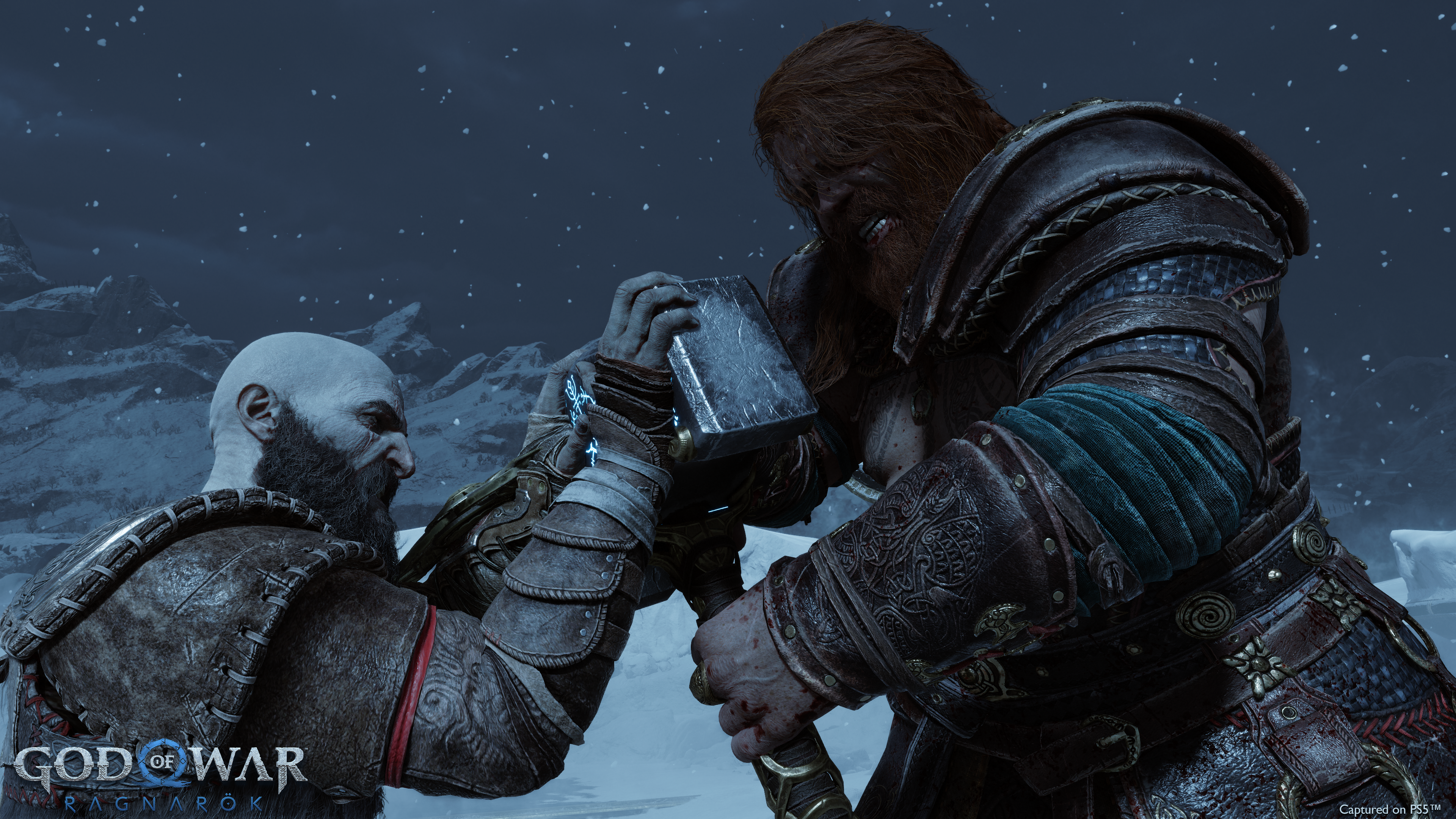We found it genuinely enlightening, especially when animation takes such a prominent role in God of War. This is a game as much about its sumptuous presentation as it is the moment-to-moment playing. From what we’ve seen so far, Kratos and Atreus maintain that same wonderful sense of personality, the detail strong enough for each moment of stillness, when it does come, to feel as deliberate as their movement.
There’s the same elastic snap to the swings and counters of Ragnarök combat’s combat as there was in 2018, and also many, many more kinds of enemy than before - something Velazquez himself knows has been a key request. It’s a rangey chat, and hopefully a fascinating insight into one essential corner of development that plays a huge part in the assembly of this game as a whole.
Eurogamer: I’ve played for a few hours and I’m enjoying what I’ve played so far. The first question is quite a broad one - it’s going to be quite an animation-focused chat - but I wanted to know how working in animation changes the way you view the world? You hear about artists sketching everything that they see in their head as they’re walking around. Do you animate people or a bus that’s going by - are you doing that all the time?
Bruno Velazquez: Yeah, so as an animator, whenever you’re just viewing the world in general, sometimes you catch yourself thinking about, ‘Wait a minute, am I really analysing the way that this person is walking, or the way that these pigeons took off from the street?’ You do catch yourself. And then especially when you’re watching a movie or TV show, or playing a video game, sometimes you have that disconnect, where you’re taken out of the film or the movie of the story, because you’re like, “Oh wait a second, I should get back into the story and not focus on how that character was moving.” So absolutely, all the time.
OK, nice - I was curious about that. One of the things that I loved about the previous game, in particular, was the little bits of animation you would do, the humanising effects. So Atreus would bounce on his toes while he’s idling, that sort of thing. Have you had any more opportunities to do that this time - has more tech enabled you to do more little things? Have there been more opportunities to work those in?
Bruno Velazquez: Yeah. One of the biggest things is that after we finished [God of War] 2018, we had a base to go off, so we were able to then, “All right, we’re gonna add a lot more, because now we have a little more time and we have the opportunity to build on something that we already have.” One thing that was great about this game is that our cast, I think, more than doubled - the amount of characters - so now we have opportunities to really show a lot of differences between them and add a lot of those little personality bits to each individual one. Because we have a bigger cast, that means a bigger contrast between personalities.
And then one big thing is that now Atreus is a teenager, as opposed to the young child that he was in the first game, we definitely had to rethink all of his movement to project more of that teenage angst he exhibits, but also that confidence that he’s gained over the years training with Kratos. It was fun to bring that in, for sure. And of course we have a wonderful cast that also brings in their own little - they know the character so well so we capture a lot of the stuff from what they’re doing, and then we just infuse that into the characters.
Have you got any favourite animations or characterisations that you’ve worked on, or that your team has worked on, in particular?
Bruno Velazquez: I’m pretty happy with a lot of the new characters that we introduced. Some of the fan favourites, including mine, are Brok and Sindri, so to be able to expand upon their personalities - you get to interact with them a lot more this time around. And there’s one particular animation for Atreus that I definitely like, where you’ll see him - I think you mentioned where he bounces on his toes - now, we have a different version where he has a little bit of that, like, Bruce Lee confidence, he’s just kind of… [Velazquez rocks from side to side a bit] Which is different from the way he jumped around in the original game, just that naive-ness of being a kid out in the world. Now it’s more confident, almost like Bruce Lee, like he’s about to wipe his nose, you know? We definitely didn’t add that part for sure! But yeah, I do enjoy that bit of Atreus.
That’s really cool. I can already see that in him just after a couple hours. How do you balance the visual fidelity side of animation and characterisation with the kind of gameplay readability you need in an action game? So with a boss fight with Thor, you’ve got elements of characterisation and animation, but I also need to be able to pick up on attack cues, the prompts, the subtle things you do. Is it quite hard to work bits of realistic animation in when you’re working around those prompts?
Bruno Velazquez: It is quite difficult. But we do have a philosophy in the team that we believe gameplay is first. As an animator, of course you want to add as much anticipation and movement and weight into every single attack. But if we were allowed to just do whatever we wanted as an animation team, we would probably make these very long animations. And from a feel and gameplay standpoint, that’s not going to feel right. So we do work very closely with the combat team and they give us a range of like, “Okay, it’d be nice if we have the hit-frame be around frame 20. And then the whole move, the recovery, should be done by frame sixty.” So we’re given some sort of goalpost. And then within those goalposts, we’re free to work on the posing and the spacing of the poses. As long as we achieve those goalposts, then yeah, we are able to reach that balance between having great looking animations and having gameplay that feels right.
Right. That’s really interesting. So it starts with a combat person giving you parameters?
Bruno Velazquez: Yeah.
One of the things I found really interesting was a thread from Jason de Heras-
Bruno Velazquez: Oh yes, yes - he worked on the previous game.
And he was talking about the difference between God of War 2018 and Sekiro: Shadows Die Twice, and how God of War is, combat-wise, more forgiving. But it’s a different type of game, so you’re not going to wait for attacks in the same way and that sort of thing. Does animation factor into that sort of philosophy as well? Are you going, “We want higher-fidelity animations because it’s more about being this cinematic thing?” And that’s why you might get more breathing room in that time-slot you’re given, if you know what I mean?
Bruno Velazquez: Yeah. So once again it goes back to the gameplay philosophy, because God of War is more about… There are other games that I feel focus more on the, for lack of a better word, hardcore aspects of gameplay - they’re very, very technical and you’re counting down to the frames. And yes, God of War does have some of that, but the combat system’s also made to have a broader appeal to try to get the casual gameplay crowd but also capture the hardcore gamers. We try to strike a balance between the two. So because of that, all that dictates how much we can add as far as animation is concerned. Of course we always want to have great fidelity, but the gameplay always comes first - we always have to strike that balance between it.
Sure. It’s super interesting. One of the things that I heard from a few people over the last couple of years was - I know it’s a depressing topic but regarding the pandemic - that motion capture was a major thing to get hit by that. Did it impact you with God of War, and what did you have to do to work around that - did you have to change your working practices and that sort of thing?
Bruno Velazquez: Yeah, absolutely. As soon as the pandemic hit, we had to hit full stop. We had to stop shooting. The biggest part was the cinematics - we still had a lot of cinematics left to shoot. So unfortunately, we had to stop. And then, as we shifted to working from home, we figured out a new system in the middle of the project, on how we were going to continue. And luckily, we had a lot of support from Sony on having protocols on how we were going to return to the stage. And you’ll most likely see a lot of Making Of, behind-the-scenes footage, where we’re all wearing masks, and we got tested and we’re wearing the extra protection. We took a lot of precautions to ensure that eventually we were able to get back to the stage. We didn’t compromise on any of the scenes. We went through and executed everything that we had planned. As you well know, the game was delayed a year to accommodate for that, to ensure that we had enough time, so I feel like we had a lot of support to adjust.
On the gameplay side, we also continued to shoot in a very safe manner with a lot of protocols. But one of the biggest things that we did is we figured out how to shoot remotely as well. So we were able to have our setup at home, and we were able to communicate with the stunt performers and give them directions through like Teams or everything done online, and somehow we pulled it off. We were able to continue to shoot even when we shifted to work from home.
That’s really cool. You mentioned support from Sony - is there a kind friendly rivalry with Naughty Dog? There’s so much prestige in animation, in particular - it’s one of the main things people talk about. Do you look at them and go, “Oh, wow, we wish we could do that thing”? Is there any of that going on?
Bruno Velazquez: I mean, absolutely. That’s one of the benefits of being part of the Sony Worldwide Studios, that we do have access to speaking to all those other teams and then share stories about pain-points and also technologies. Before the pandemic… We are close enough to Naughty Dog, not only from personal communication but also the distance - we’re not that far away. So we did actually organise, a couple of times, some lunches, where we got out to the park, got to mingle and talk, and enjoy some good food and hang out.
So yes of course we want to push each other to make better games. And of course it’s a little bit of friendly competition. But I feel it’s also been incredibly beneficial to be part of this family where we get to share a lot of stuff. Talking to the folks at Insomniac, the amazing team that they have over there doing Spider-Man, we’re always inspired by them as well. And Sucker Punch, the stuff they did in Ghost [of Tsushima], it’s really amazing. So yeah, it’s definitely a friendly rivalry, but at the same time it’s very collaborative as well.
One thing that always comes up - you touched on it very briefly earlier actually - is this notion of reused animations. And there’s always someone who has something to say about, “This animation of getting into the boat” - or whatever - “is the same as the last one.” Is there anything that you wish you could explain, or want to set the record straight on? Like, this is how it’s done when you work on a series of games. Can you maybe explain that for people who might be thinking along those lines?
Bruno Velazquez: Yeah. Our goal, when we first set out to do this game, was to take what we have already built on the previous one and expand on it. So there’s definitely some choices that we have to make where it didn’t make sense to do everything from scratch again, so of course there’s going to be a bit of reuse. But that allows us to then create a whole new set of animations and a whole new set of things that we were not able to do in the previous game.
So one of the biggest pieces of feedback we got from the animation perspective from [God of War] 2018, was players wish that there was more enemy variety in the game. And also, as far as bosses and mini-bosses, they would have loved to have more variety. And then one of my biggest pet-peeves personally was the finishing moves. So those were all areas that we said, “Okay, we’re going to invest a lot of time and effort into ensuring that on God of War: Ragnarok, we have all those bases covered.” So now, as you play the game, you’re going to notice that we have a lot more enemy variety - not only humanoid types but we have a lot of cool creatures that, you know, you cannot motion capture, so we were able to spend more time - by not redoing everything - on creating these awesome creatures that Kratos and Atreus will encounter. And then we have more mini-bosses, we have more boss encounters throughout this game.
And then the biggest thing, for the first time in the franchise’s history, is that we have weapon-specific finishing moves. So depending on whether you have the Blades, or if you have the axe equipped, you’re going to get a unique kill. So it’s going to be fun to like, “All right, let me see what the Blades do against this enemy. Let me see what the axe…” So we were able to accomplish that. This is something that I’ve been wanting to do since God of War 2 or 3, where you equip the weapon and you go to finish [the enemy], and then he [Kratos] always went back to the Blades. But now, finally, we were able to achieve that. So to me, not redoing everything allows us to do a lot more.
Good answer! One of the other things that always comes up is the conversation about sort frame-rates and fidelity versus performance. Where’s your position on that? Obviously, you have the choice between the two modes in God of War. Does that take a lot of extra work to have both of those options, and is that something you have to factor in with how you’re making the game? Do you have a preference between the two?
Bruno Velazquez: Of course as an animator, I love a higher frame rate - I want to see the smoothest motion possible. When it comes to God of War: Ragnarok, from the very get-go, we knew that this was going to be a PS4 game, because we wanted to support the fanbase - we had so many people that had enjoyed the game on PS4. So from the very beginning, we knew, okay, this is going to be a PS4 game; we’re going to make this the best PS4 game we can make. Our goal was to surpass God of War 2018 in every way possible. Having the PS5 version, that’s just icing on the cake.
So our goal is let’s make the best PS4 game; push on fidelity, content, bring the story to a close that we started - that was our primary goal. PS5, it’s just like haptic feedback, 3D audio, higher frame-rate and better graphics and textures. That’s just like the icing on the cake. So of course the PS5 version is going to be the best way to experience it, but the PS4 [version] is going to be one of the games that pushes the PS4 to the max. Taking that philosophy and approach into it helped us to set the goalposts for ourselves, that we want to make a great PS4 experience and an even better PS5 experience.
You’ve kind of answered this but I was going to ask you about PS4 and working with a cross-generational game, when we’re a couple of years into the new generation as well. Is there a sense that you feel a little bit restrained by working with the older console? Is there stuff that maybe you either wish you could do, or that would have found its way in there, if you weren’t working with an older generation?
Bruno Velazquez: What’s unique about this game is that because we originally set off to make the best PS4 version, there were certain goals that we wanted to achieve, like conclude the story, double the cast of characters, have more enemy variety, do those weapons specific kills. So all the things that we set out to do, we were able to achieve on the PS4. Because of that, we didn’t really feel that we were restricted in any way, because all the goals that we set out to do, we were able to achieve. And like I mentioned before, the PS5 basically just made the game that much better. So because that was our philosophy going into it, we never really felt restricted on the goals that we set out for ourselves.
Sure. You mentioned some of the new characters. I am a big fan of your take on Thor - I think he’s really fun. I love the strong man idea. Genuinely a stroke of genius to work him in like that. From an animation perspective, and also just generally, what’s your approach been for putting a new spin on established characters? Has it been a challenge trying to find a way to reimagine things that people have quite a good idea about? Like, it’s not just Marvel with Thor - he’s obviously been kicking around for thousands of years. So what’s that been like and what have you generally aimed to achieve with it?
Bruno Velazquez: We’ve always aimed to have our own interpretation of mythology, even from the Greek games, [and] now in the Norse games. We always wanted to see how we could add our own twist to it. So of course it applies to Thor.
One of the little quirks that we always wanted to do was we made him left-handed, to have contrast with Kratos and with other depictions of Thor. You always see the standard ‘hold the hand out to summon back the hammer’, but for our particular version of Thor, we have the thing where he always snaps his fingers to call back the hammer. And we avoided certain things like spinning the hammer around, which is something that is used in another medium. And also the look of the character: just like making him a little bit more inspired by some of the original Norse texts, we wanted to get a little closer to that.
At the same time, we had established all this lore about him in [God of War] 2018, that he was a ruthless killer and he was someone to be feared, and we wanted to depict that as well. But we wanted to add a little bit more of a dimensionality to him. So as you get through the game, you’re going to see more of some of the relationships he has with his own family. Because in the end, this game is all about family relationships. You’ve got Kratos and Atreus; you’ve got Thor and his family; you’re going to see Odin, he’s a father himself; Freya, she’s a grieving mother now. So you’re going to see all these relationships develop. So we wanted to also show a different side of Thor in that sense, that he’s not just a killing machine but there’s a bit more humanity to him. And not everything in our game is black and white.
Yeah. A bit of a topic shift, but one thing I’m really interested in, is AI in game development. Concept art has been the main point of discussion recently. I’m really curious to know if that’s impacted animation yet, or if you expect it to, and how you might expect that to influence how you’re developing games?
Bruno Velazquez: So for God of War: Ragnarok, especially since it’s been in development since 2018, we haven’t implemented too many of the AI features that are popping up now. But I could see, definitely in the future, especially when creating games with a lot of crowds, I could see how getting more of that technology in place could be beneficial to drive the behaviours of characters so that they’re more autonomous rather than very custom made. Because that’s what takes a long time, when you create all these custom-made sequences for characters, that need they need to follow. But if you feed them with a library of motions and then the AI takes over, that could definitely save a lot of time and create more of a fidelity or randomness to the game experience. So definitely I’m looking forward to exploring those things in the future.
That’s pretty cool. Final one, and it’s quite a broad question about animation in general, but if you could magically solve one problem, or make one obstacle go away in animating video games, what would you do?
Bruno Velazquez: Oh wow that’s a loaded question [laughs]. I joke, but maybe create an animate button that you just press… We could always find ways to improve our motion capture process. It’s always a pleasure to work with stunt performers and actors. Maybe having ways to have less cumbersome ways of capturing, because they have to wear all these suits and these markers, and sometimes they have these cameras to capture their faces. If we can minimise and reduce the equipment and setup that it takes to capture these performances, I feel like that would be a huge breakthrough. So I know there’s already talks about doing markerless motion capture with only cameras, and you can just wear your regular clothes and capture motion. Once that technology advances and we can get the results of capturing the motion a lot faster, that’s really going to revolutionise making games for sure.
That’s it for me so a big thank you. It’s been really interesting.
